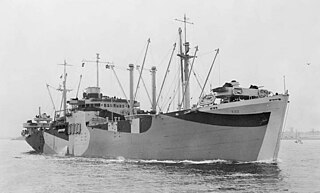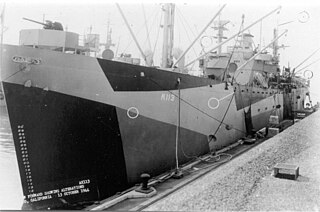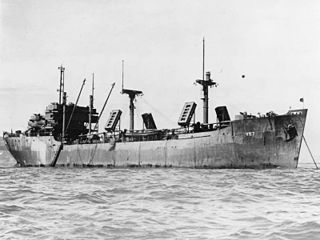
USS Antrim (AK-159) was an Alamosa-class cargo ship in the United States Navy. She was named for Antrim County, Michigan.

USS Situla (AK-140) was a Crater-class cargo ship in the service of the United States Navy in World War II. It was the only ship of the Navy to have borne this name. It is named after the star Situla.

USS Crater (AK-70) was the lead ship of her class of converted liberty ship cargo ships in the service of the US Navy in World War II. She was first named after John James Audubon, an American ornithologist, naturalist, and painter. She was renamed and commissioned after the constellation Crater, she was the only ship of the Navy to bear this name.

USS Grumium (AK-112/IX-174/AVS-3) was a Crater-class cargo ship and aviation supply ship in the service of the US Navy in World War II. Named after the star Grumium in the constellation Draco, it was the only ship of the Navy to bear this name.

Type C1 was a designation for cargo ships built for the United States Maritime Commission before and during World War II. Total production was 493 ships built from 1940 to 1945. The first C1 types were the smallest of the three original Maritime Commission designs, meant for shorter routes where high speed and capacity were less important. Only a handful were delivered prior to Pearl Harbor. But many C1-A and C1-B ships were already in the works and were delivered during 1942. Many were converted to military purposes including troop transports during the war.

USS Allioth (AK-109/IX-204/AVS-4) was a Crater-class cargo ship commissioned by the US Navy for service in World War II, named after Alioth, a star in constellation Ursa Major. She was responsible for delivering troops, goods and equipment to locations in the war zone.

USS Rutilicus (AK-113) was a Crater-class cargo ship commissioned by the US Navy for service in World War II. She was responsible for delivering troops, goods and equipment to locations in the Asiatic-Pacific Theater.
USS Propus (AK-132) was a Crater-class cargo ship, converted from a Liberty Ship, commissioned by the US Navy for service in World War II. She was first named after Frederick Tresca, a French-born lighthouse keeper, sea captain, pioneer shipping man, and Union blockade runner in Florida. She was renamed and commissioned after Propus, a star in the constellation Gemini. She was responsible for delivering troops, goods and equipment to locations in the war zone.

USS Beaverhead (AK-161) was an Alamosa-class cargo ship commissioned by the U.S. Navy for service in World War II. She was responsible for delivering troops, goods and equipment to locations in the war zone.

USS Cabell (AK-166) was an Alamosa-class cargo ship commissioned by the US Navy for service in World War II. She was responsible for delivering troops, goods and equipment to locations in the war zone.
USS Chicot (AK-170) was an Alamosa-class cargo ship commissioned by the US Navy for service in World War II. She was responsible for delivering troops, goods and equipment to locations in the war zone.
USS Clarion (AK-172) was an Alamosa-class cargo ship commissioned by the U.S. Navy for service in World War II. She was responsible for delivering troops, goods and equipment to locations in the war zone.
USS Gwinnett (AK-185/AG-92/AVS-5) was originally an Alamosa-class cargo ship acquired by the U.S. Navy shortly before the end of World War II and converted into a Gwinnett-class aviation stores issue ship. She was found to be excess-to-needs and was placed into reserve in 1946.

USS Pontotoc (AK-206/AG-94/AVS-7) was an Alamosa-class cargo ship acquired by the US Navy shortly before the end of World War II. She was converted into a Gwinnett-class aviation stores issue ship to carry aviation parts and spares, and to issue them to the US Pacific Fleet and activities as needed.

USS Poinsett (AK-205) was an Alamosa-class cargo ship acquired by the US Navy just prior to the end of World War II. She carried supplies and ammunition to the Pacific Ocean battle areas and was awarded one battle star for her operations in the Borneo area.
USS Glacier (AK-183) was an Alamosa-class cargo ship acquired by the U.S. Navy during the final months of World War II. She served in the Pacific Ocean theatre of operations for a short period of time before being decommissioned and returned to the U.S. Maritime Administration for dispositioning.

USS Grainger (AK-184) was an Alamosa-class cargo ship that served the US Navy during the final months of World War II. In 1947 she was placed back in service and served in the Korean War, earning two battle stars
USS Muscatine (AK-197) was an Alamosa-class cargo ship that was constructed for the US Navy under a US Maritime Commission contract during the closing period of World War II. She had a brief career before being decommissioned a year later.
USS Pemiscot (AK-201) was an Alamosa-class cargo ship that was constructed for the US Navy during the closing period of World War II. By the time she was scheduled for commissioning, the war's end caused her to be declared “excess to needs” and she was returned to the US Government and struck by the Navy.

USS Screven (AK-210) was an Alamosa-class cargo ship that was constructed for the US Navy during the closing period of World War II. She served in the Pacific Ocean theatre of operations and returned home in 1946 to be placed into the "mothball fleet" where she remained until sold in 1947 for commercial maritime service.
This page is based on this
Wikipedia article Text is available under the
CC BY-SA 4.0 license; additional terms may apply.
Images, videos and audio are available under their respective licenses.













